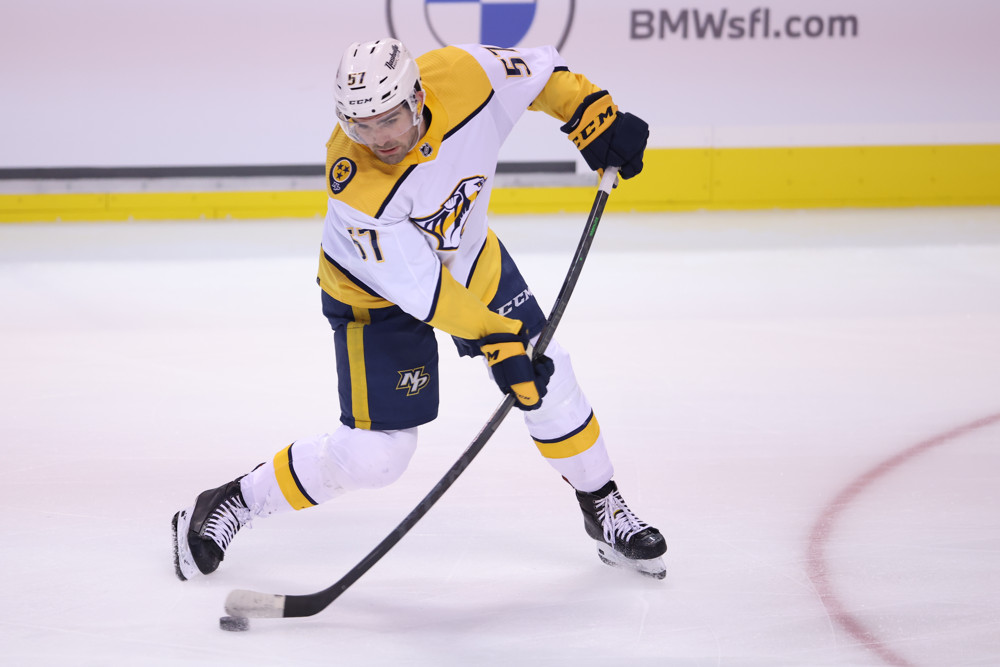How Dante Fabbro Is Stabilizing Predators’ Top Pairing
When Roman Josi won the Norris Trophy two seasons ago, his partner was Ryan Ellis. The grizzled vet provided a steady defensive conscience that granted Josi the green light to wreak havoc with the puck on his stick. Nashville’s captain is at his best when he doesn’t stop to think. He just floors it.
Last year, Josi’s performance suffered because he wasn’t confident that his pairmate could handle the responsibility of playing alongside a relentless rover. Ellis missed 21 games with a hand injury, while Dante Fabbro and Matt Benning both struggled to fill his shoes. Consequently, Josi couldn’t commit to throwing the kitchen sink at the opposition. He second-guessed every decision rather than trusting his first instinct. The Predators’ outlook seemingly worsened when they dealt Ellis to the Philadelphia Flyers in July, forcing either Fabbro or Alexandre Carrier into a considerably larger role.
It’s fair to say Fabbro has seized his opportunity. Through 57 outings, the 23-year-old is offering the quiet, steady presence that Josi requires to activate as he sees fit. The fresh-faced blueliner who could barely keep his head above water next to Mattias Ekholm now looks as cool as a cucumber beside one of the most aggressive blueliners in the world. This development has helped Josi rediscover his Norris Trophy form and played a large part in the Predators’ 33-20-4 record that has them sitting in a wild-card spot.
The former first-round pick’s biggest strength is as unspectacular as it is vital to team success: transition defense. He focuses on claiming the middle of the ice and taking the correct depth to funnel puck-carriers into the boards, effectively painting them into a corner:
Without eye-popping physical tools (6’0”, 189 lbs) or puck skills, Fabbro wasn’t able to wow fans upon his arrival. The NHL isn’t college. To his credit, he’s put in the work, carved out his place on the roster and refined his craft to the point where he’s become one of the more promising positional defenders around.
As the last man back, he opts for a conservative approach instead of pushing up with a tight gap in the neutral zone. His pinpoint angling on entries prevents cutbacks, leaving opponents with a choice between stopping up or skating right into a squeeze. One option affords Fabbro’s teammates the time they need to hustle back into the fray. The other turns clear possession into a 50/50 proposition. Either way, he’s denied the offense’s preferred look. He stops their momentum before it ever develops.
His stubborn refusal to concede prime real estate has yielded excellent underlying numbers. Among the 36 blue-line duos who have logged at least 500 minutes together at 5-on-5 this season, Fabbro and Josi are surrendering the fewest high-danger chances and fourth-fewest expected goals. They may not dominate in pure shot attempt control, but they dictate the terms where it matters most.
Of course, keeping opponents out of Nashville’s zone entirely isn’t possible. Therefore, Fabbro must be able to thwart them once their attack has been established. He does a solid job in this respect too:
Fabbro leverages his mobility to contest pucks or win races to them altogether. If he can’t get there, his angling shines again. He takes smart paths to limit time and space, and he displays a knack for occupying passing and shooting lanes. Other than on odd-man rushes, which remain a weakness for him, Fabbro’s positioning has improved by leaps and bounds. And when Nashville’s defensive structure falters, he showcases a quick stick that can bail the team out during net-front scrambles.
He’s just getting better at seeing and subsequently taking away what the offense wants. He seems more attuned to the NHL’s tempo. He’s also gaining a stronger grasp on Josi’s tendencies and how he can complement them. As a result, they’re delivering outstanding defensive numbers. Together, they rank 11th in actual goals against with a sparkling 1.90 per 60 minutes.
Surviving on defense is great, but in order to count yourself among the best pairings in the world, you need to tilt the ice toward the opposition’s crease too. Thankfully, Fabbro’s increased comfort level is reflected in his puck management as well:
Where he once panicked at the sight of forecheckers, he now assesses how much time he has to make a play and acts accordingly. He can buy time with his feet or stall for a half-second to create a better passing avenue. Then his talent grabs the reins. He isn’t going to dance through a whole team by himself, but he possesses the vision and touch to get the Predators moving in the right direction.
There’s almost a Senators-era Wade Redden quality to his style. Smooth skating, understated defense and a crisp first pass. He rarely turns pucks over either. Those ingredients ensure that Fabbro and Josi don’t spend many shifts hemmed in their end. On the whole, the pairing owns 54.9% of the expected goals and 61.8% of the actual goals during their shifts.
Fabbro obviously isn’t the game-changer in this partnership, but his ability to lock down that first-pairing role has emboldened Josi to lean into his adventurous designs without fear of defensive repercussions. He can fly up the ice without looking down. Consequently, the 2019-20 Norris Trophy winner is producing at the highest rate of his career, leading his team in scoring and squarely in the conversation for the award this season.
A strong safety net goes a long way.
Recent Posts

How Corey Perry Is Making His Presence Felt With the Lightning
View Post »
How Adam Fox Pushed the Rangers Past the Penguins
View Post »

